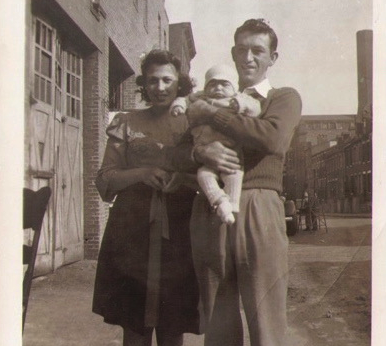Lately, I have been wondering about those patterns. I have been wondering if we inherit misfortune, the way we inherit eye color, hair color, left handedness.
1. My grandmother’s first child was born in August 1942. He died in January 1943. The word baby appears at the top his tombstone. The age 4 ½ months appears on the bottom.
2. He died in the same hospital where he was born. He died in the hospital where my mother was born 11 years later.
3. He died in the hospital where my sister gave birth to her first child. A boy, born in August.
4. All of my grandmother’s granddaughters have given birth except for me. Their first children have been boys.
5. Eleven months after she lost her son, my grandmother gave birth to a girl. She named her daughter for her lost son. Beverly. Bernard.
6. Beverly and Bernard had blonde hair, blue-green eyes. Seven letters in each of their names.
7. Family systems psychologists believe patterns repeat in families. Behaviors duplicate. Addictions multiply. We choose our partners based on our parents, our siblings, our grandparents. We echo their patterns, or repeat them, or break them. Lately, I have been wondering about those patterns. I have been wondering if we inherit misfortune, the way we inherit eye color, hair color, left handedness.
8. How else to explain the patterns of misfortune that cycle through families, a genealogy of loss? Or specifically, how else to explain the patterns of misfortune that cycle through my family, all the sad coincidences?
9. Some researchers believe anxiety travels in our genes. Others says it doesn’t. Who can really know?
10. In college, when I was overwhelmed, my mother told me to make lists.
11. She said, “Once it’s down on paper, you can make sense of anything.”
12. So here’s what I know:
13. When Bernard started to cry, my grandmother called the doctor. She told him her son kept pulling on his ear. She did not believe the doctor’s over-the-phone diagnosis of an ear infection. The doctor did not listen to her persistent pleas. I am afraid the doctor perceived her as a complainer. I am afraid he was a man who did not perceive a woman as credible.
14. When I was pregnant, I started writing about Bernard.
15. I do not know why. Maybe I was afraid I was going to miscarry. Maybe I already knew I would. (Intuition runs in the family.) Maybe I wanted to understand my grandmother in a new way –– mother-to-mother.
16. When I was pregnant, I requested Bernard’s death certificate.
17. A few days later, I started to bleed.
18. My husband tells me correlation does not necessitate causation. He is an ENTJ on the Myers Briggs. I am an INFJ, the most intuitive personality type.
19. A midwife examined me on a Friday afternoon. She told me I’d have to wait until Monday to receive my lab test results. She would not tell me I was having a miscarriage because she did not want to “be wrong and look stupid.”
20. Her doubt fed mine.
21. Even after I peed on a pregnancy test stick and received a negative result, I doubted the intuition that ripped through me.
22. When Monday came, I called to complain about the midwife. I asked for a written apology. My family tragedy was not about her self-perception or lack of confidence or whatever she had going on in her head that day.
23. I am still waiting. I have, however, received a bill for the trans vaginal ultrasound she performed, a procedure that women identify as traumatic. I had two trans vaginal ultrasounds in one week.
24. Bernard died on January 4, 1943. A Monday.
25. Beverly’s first and only son was born in January 1966. He was 46 when he died. His mother was 69.
26. I was out of town when Bernard’s death certificate arrived, but my husband e-mailed me a photo.
27. The cause of death is adrenal hemorrhage caused by bacterial meningitis. No ear infection recorded.
28. The family buried Bernard on June 5, 1943. They had to wait because the ground was frozen solid that winter. Jewish custom is to bury the dead within 24 to 48 hours.
29. All winter and spring, Bernard’s body lay in a freezer, in a morgue.
30. By his funeral, my grandmother was already pregnant with Beverly. I imagine her standing at the grave, full-bellied and overfull of grief. How did she stand there? How did she not slide into the same darkness that held her son?
31. Five years later, she delivered a second son on June 6. Her son lived past infancy. He has survived two sisters and one brother, a mother, a father, a nephew.
32. In Hebrew School, our teachers said ancient rabbis did not consider a child to be a child until it cried. They said a child was not a child until the eighth day, when circumcision was performed, or a name was given. At 13, I thought this sounded like a clever rule. Now, not so much.
33. Jewish mystics believe the number 36 is a symbol for life multiplied. Double chai, it’s called. I conceived at 36. I miscarried at 36.
34. My grandmother lost a child in 1943.
35. I lost someone who has no name in 2017. I lost hope, possibility, my last shreds of faith.
36. But I am making a list. I am trying to make sense of it all.
Magin LaSov Gregg lives, writes, and teaches in Frederick, Maryland. Her writing has appeared or is forthcoming in The Washington Post, The Huffington Post, The Rumpus, River Teeth’s Beautiful Things, Pithead Chapel, Hippocampus Magazine, and The Bellingham Review. She blogs at www.maginlasovgregg.com and tweets @maginlasovgregg.
Photo provided by the author of her grandparents and baby Bernard in 1942.
Other Links:

